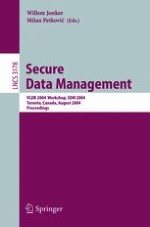Concepts like ubiquitous computing and ambient intelligence that exploit - creasingly interconnected networks and mobility put new requirements on data management. An important element in the connected world is that data will be accessible anytime anywhere. This also has its downside in that it becomes easier to get unauthorized data access. Furthermore, it will become easier to collect, store, and search personal information and endanger people’s privacy. As a result security and privacy of data becomes more and more of an issue. Therefore, secure data management, which is also privacy-enhanced, turns out to be a challenging goal that will also seriously in?uence the acceptance of ub- uitous computing and ambient intelligence concepts by society. With the above in mind, we organized the SDM 2004 workshop to initiate and promote secure data management as one of the important interdisciplinary - search ?elds that brings together people from the security research community and the data management research community. The call for papers attracted 28 submissions both from universities and industry. The program committee selected 15 researchpapers for presentation at the workshop.The technical c- tributions presented at the SDM workshop are collected in this volume, which, wehope,willserveasavaluableresearchandreferencebookinyourprofessional life.
